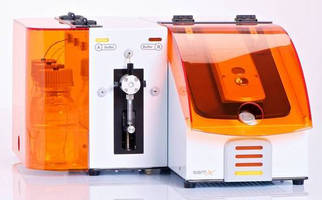Sensors / Detectors / Transducers
Acoustic Biosensor offers 8 channels and adaptable routing.
Share:
Press Release Summary:

Featuring 2 sensor chips to aid parallel processing of samples, sam®X uses Surface Acoustic Wave technology to detect mass binding and protein conformational changes on whole cells in real time. It does not require complex labeling methods and can be used to investigate living cells. Using fluidics, each channel can by utilized independently or via sequential combinations of 4 x 2, 2 x 4, or 1 x 8 channels. Different ligands can be immobilized online at each chip position automatically.
Original Press Release:
SAW Instruments Launches New sam®X Acoustic Biosensor at MipTec 2011
Powerful and Flexible Multi-Channel Binding Analysis Using Living Cells
Basel, Switzerland: SAW Instruments GmbH, developer of innovative biosensor technology for life sciences research in biotech and academia, has launched the sam®X acoustic biosensor in Europe at MipTec, Basel, Switzerland (20-22 September). sam®X is the latest high-end addition to the sam® range of acoustic biosensors, featuring eight analysis channels and adaptable routing that expands the workflow options available for increased power and flexibility. The new system uses SAW's proven proprietary Surface Acoustic Wave technology to detect mass binding and protein conformational changes on whole cells. Unlike many similar detection platforms, SAW's range of sam® acoustic biosensors do not require complex labelling methods, are real-time rather than equilibrium and can be used to investigate living cells rather than fixed cells or purified proteins, providing a faster and more insightful method of analysis.
The new sam®X has two sensor chips for higher-end users, rather than the single chip of existing sam®5 models, increasing the number of channels to eight, further facilitating the parallel processing of samples. Using sophisticated fluidics, each channel can by utilised independently or via sequential combinations of 4 x 2, 2 x 4 or 1 x 8 channels. This optimises user workflow, regardless of whether discrete or common reagents need to be delivered to particular sensor chip positions. In addition, different ligands can now be immobilized on-line at each chip position automatically, without the need for time-consuming, off-line protein loading. This approach is ideal for directly quantifying the amount of protein bound to the sensor chip surface, giving more accurate and reliable results.
Dr Markus Perpeet, Managing Director of SAW, commented: "We are very excited to introduce users to the sam®X, which further extends the flexibility offered by our range of biosensors. The new system facilitates more complex assay design and can be easily adapted to meet the needs of each user, while increasing throughput speed and accuracy. It is particularly well suited to providing binding constants and kinetics data for ligands binding to membrane targets on cells, while results are obtained significantly faster than those from equilibrium-based methods."
SAW will be demonstrating the sam®X in action at its MipTech booth, and will present a poster entitled "Binding Kinetics of Therapeutic Antibodies to Native Proteins on Living Cells". The poster, which discusses data generated using antibodies produced by Affimed Therapeutics AG when they were applied to living tumour cells, can be viewed on Thursday 22nd September, 1pm-2.30pm (Poster Number 207).
For more information on the sam®X and other SAW systems, visit the SAW booth at MipTec or see www.saw-instruments.de.
Notes on the technology
Surface Acoustic Wave technology is based on the ability of a wave of energy to travel across the surface of a material. Each surface has a typical inherent elasticity affecting the way the energy of the wave dissipates as it travels across the surface of the material being analysed. Thus, the nature of the surface in question, and therefore any changes to it, can be assessed by sensors monitoring the behaviour of the wave as it propagates across the surface. In particular, changes in mass result in alterations to the phase of the wave, whilst viscoelastic and conformational characteristics influence wave amplitude. The technology developed and employed by SAW instruments is capable of accurately interpreting this information in order to provide real time readouts measuring binding and conformational changes in the samples through which the wave passes.
About SAW Instruments GmbH
SAW Instruments GmbH designs, develops and sells biosensor-based laboratory instruments for life sciences research. The proprietary technology of SAW Instruments employs a Surface Acoustic Waves approach to biological measurement, rather than using traditional optical methods such as SPR. The technology is uniquely positioned compared to other biosensor technologies based on its ability to measure conformational changes in cells, membranes and vesicles. In addition, the system is also capable of providing other industry standard measurements including those involving kinetics, quantitation and affinity.
SAW instruments has more than ten years experience in the field of label-free biosensor technology and a number of our customers have successfully published work employing the platform. It is our goal is to continue to build on this experience, as well as to develop a family of workflow-driven products to further meet our customers' needs.




